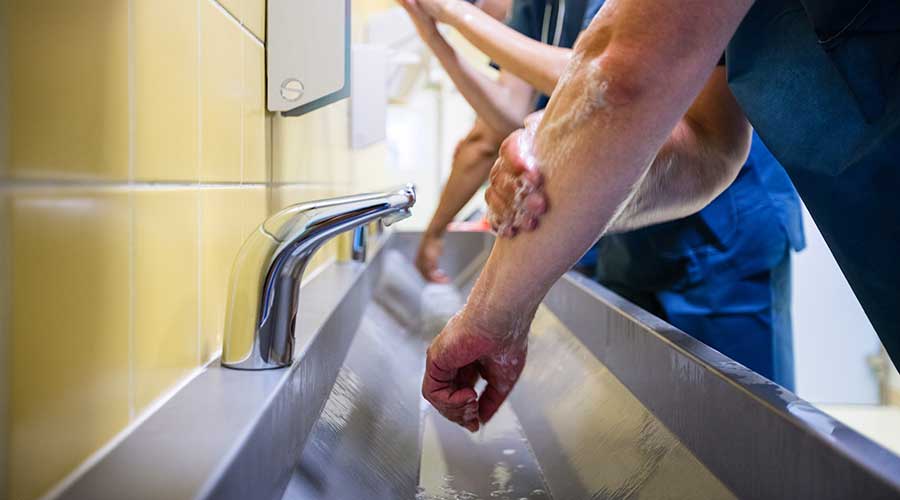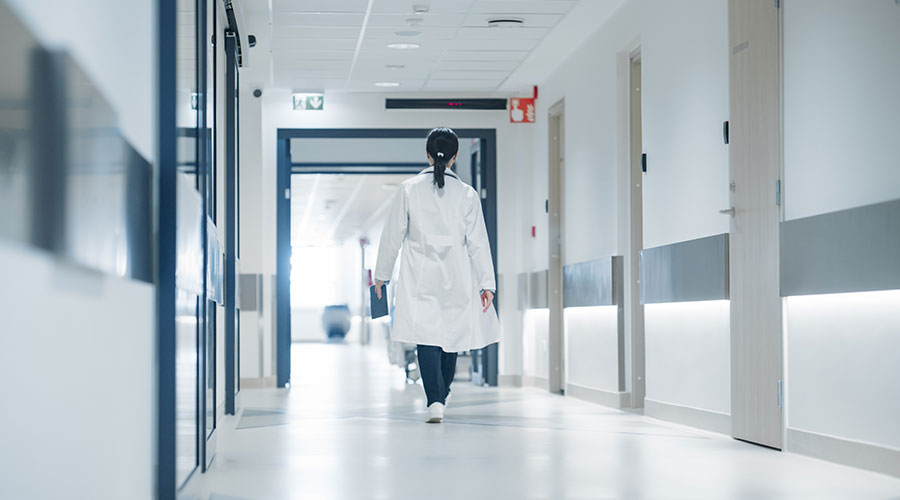Clean hands are essential, but cleaning them is only the first step. Caregivers also need to learn how to prevent their hands or gloves from becoming re-contaminated before touching a patient.
Stand in an emergency room, and watch caregivers clean their hands, put on gloves and pull open the privacy curtain to see the next patient. That curtain is seldom changed, and it is frequently full of bacteria. The result? Caregivers’ gloves are soiled again.
If surfaces in hospitals and other healthcare facilities are inadequately cleaned, caregivers’ hands will become re-contaminated seconds after they wash them. How dirty are hospitals? Boston University researchers examining 49 operating rooms in four New England teaching hospitals found that the cleaning staff overlooked more than one-half the objects that should have been disinfected.
A follow-up study of patients’ rooms in 20 hospitals in Washington, D.C., Connecticut and Massachusetts found that the cleaning staff overlooked more than one-half the surfaces that are supposed to be cleaned after a patient is discharged and before the next patient is admitted.
Research also shows that nearly three quarters of patients’ rooms are contaminated with Methicillin-resistant Staphylococcus aureus (MRSA) and Vancomycin-resistant enterococci (VRE). These bacteria are on cabinets, countertops, bedrails, bedside tables and other surfaces. Once patients and caregivers touch these surfaces, their hands become vectors for disease.
One study showed that when a nurse walks into a room occupied by a patient with MRSA and has no patient contact but touches objects in the room, the nurse’s gloves are contaminated 42 percent of the time when leaving the room. MRSA and VRE can live for many hours on surfaces and fabrics. Thorough cleaning is highly effective in reducing the spread of drug-resistant bacteria to patients.
In a 2006 study, researchers at Rush University Medical Center in Chicago trained the environmental services staff to soak surfaces with detergent and wait, rather than merely spraying and quickly wiping, and to clean commonly overlooked objects such as telephones, remote controls and faucets. The result was a two-thirds reduction in the spread of VRE to patients.
Even the cash-strapped British National Health Service recognizes that intensive cleaning is a bargain compared with the cost of treating infections. By nearly doubling cleaning staff hours on one ward, and with no other interventions, a hospital in Dorchester, England, reduced the spread of MRSA by 90 percent. The financial results were also impressive. Savings from infections avoided were 3.5 times the cost of the added cleaning.
Research highlights the danger of MRSA and other superbugs lingering on surfaces long after the patient who carried them has been discharged. In one nine-bed intensive care unit (ICU), more than one-half the patients who picked up MRSA after entering the ICU acquired a strain of the bacteria not present on other patients in the ICU at the time. In other words, the bacteria had been left behind on floors, bedrails, tables and other surfaces by patients who already had been discharged.
Placing a patient in a room or even a wheelchair previously used by someone who unknowingly carried MRSA puts that patient at risk. When hospitals fail to identify which patients are carrying superbugs, hospital uniforms and equipment become conveyor belts for infection. When doctors and nurses lean over a patient with MRSA bacteria, their white coats and uniforms pick up that bacterium 65 percent of the time, allowing it to be carried to other patients.
Clean hands touching clean surfaces and equipment saves lives.
J. Darrel Hicks, BA, MESRE, CHESP, Certificate of Mastery in Infection Prevention is the Past President of the Healthcare Surfaces Institute. Hicks is nationally recognized as a subject matter expert in infection prevention and control as it relates to cleaning. He is the owner/principal of Safe, Clean and Disinfected. His enterprise specializes in B2B consulting, webinar presentations, seminars and facility consulting services related to cleaning and disinfection. Learn more at www.darrelhicks.com.

 Should We Be Testing Toilet Water in Patient Restrooms?
Should We Be Testing Toilet Water in Patient Restrooms? Healthcare Union Petitions for Increased Staff Safety at HCA Florida Hospitals
Healthcare Union Petitions for Increased Staff Safety at HCA Florida Hospitals HGA Announces Completion of the Jeffrey and Patricia Cole Pavilion
HGA Announces Completion of the Jeffrey and Patricia Cole Pavilion Healthcare Facilities Look to Future-Proof Facilities
Healthcare Facilities Look to Future-Proof Facilities Yale New Haven Health Experiences Data Breach
Yale New Haven Health Experiences Data Breach